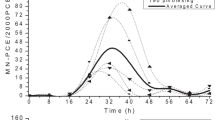Abstract
We analyzed the induction of sister chromatid exchange (SCE) by cyclosporin A (CsA) as a marker of genotoxic potential. In 30 patients undergoing renal transplantation, SCE induction was tested before the introduction of CsA and 3 months later. We found that SCE frequency increased significantly at the end of 3 months. To our knowledge, this is the first study demonstrating in vivo induction of SCE by CsA in humans. We conclude that CsA has a genotoxic potential on human lymphocytes.
Similar content being viewed by others
References
Beveridge T, Krupp P, McKibbin C. Letters to the editor: lymphomas and lymphoproliferative lesions developing under cyclosporine therapy. Lancet. 1984;1:788.
Borel JF. Cyclosporine A: present experimental studies. Transplant Proc. 1981;13:344-8.
Borel JF, Feurer C, Gubler H, Stahelin H. Biological effects of cyclosporine A: a new anti-lymphocytic agent. Agent Actions. 1976;4:468-76.
Borel JF, Fewer C, Magnee C, Stahelin H. Effects of the new antilymphocytic peptide cyclosporine A in animals. Immunology. 1977;32:1017-21.
Calne RY, White DJG, Evans DB et al. Cyclosporine A in cadaveric organ transplantation. Br Med J. 1981;282:934-8.
Cammisuli S. The effect of cyclosporine A on cell interactions within the immune system. In: White DJG, ed. Cyclosporine A. Amsterdam: Elsevier; 1982:243-7.
Dean BJ, Danford N. Assays for the detection of chemically-induced chromosome damage in cultured mammalian cells. In: Venitt S, Parry JM, eds. Mutagenicity testing. A practical approach. Oxford: Oxford University Press; 1984:187-232.
Gebhart E. Sister chromatid exchanges and structural chromosome aberration in mutagenicity testing. Hum Genet. 1981; 58:235-54.
Hess AD, Tutschka PJ, Santos GW. The effect of cyclosporine A on T-lymphocyte subpopulations. In: White DJG, ed. Cyclosporine A. Amsterdam: Elsevier; 1982:209-13.
Matter BE, Donatsch PP, Raube RR, Schmid B, Schmid W. Genotoxicity evaluation of cyclosporine A, a new immunosuppressive agent. Mutat Res. 1982;105:257-61.
Nakanishi Y, Schneider EL. In vivo sister chromatid exchange. A sensitive measure of DNA damage. Mutat Res. 1979;60:329-37.
Olshan AF, Mattison DR, Zwanenburg TS. International Commission for Protection Against Environmental Mutagens and Carcinogens. Cyclosporine A: review of genotoxicity and potential for adverse human reproductive and developmental effects. Report of a working group on the genotoxicity of Cyclosporine A. Mutat Res. 1994;317(2):163-73.
Paavonen T, Hayry P. Effect of cyclosporine A on T-dependent and independent immunoglobulin synthesis in vitro. Nature. 1980;287:542-5.
Penn I. Lymphomas complicating organ transplantation. Transplant Proc. 1983;15:2790-6.
Perry Y, Evans H. Cytological detection of mutagen carcinogen exposure by sister chromatid exchange. Nature. 1975;258:121-5.
Physicians' Desk Reference. Montreal: Medical Economics Company; 1997:2405-9.
Richardson A. Analysis of cytogenetic abnormalities. In: Barch MJ, ed. ACT cytogenetics laboratory manual, 2nd ed. New York: Raven Press; 1991.
Ryffel B, Donatsch PP, Madorin M et al. Toxicologicl evaluation of cyclosporine A. Arch Toxicol. 1983;53:107-10.
Sarto F, Faccioli MC, Cominato I, Levis AG. Aging and smoking increase the frequency of sister-chromatid exchanges (SCE) in man. Mutat Res. 1985;144:183-7.
Seino Y, Nagao M, Yagahi T et al. Mutagenicity of several classes of antitumor agents to Salmonella typhimurium TA 98, TA 100 and TA 92. Cancer Res. 1978;38:2148-54.
Speck WT, Rosenkranz HS. Mutagenicity of azathioprine. Cancer Res. 1976;36:108-12.
White DJG, Plumb AM, Pawelec G, Brons G. Cyclosporine A: an immunosuppressive agent preferentially active against proliferating T-cells. Transplantation. 1979;27:55-63.
Wollf S, Perry P. Differential giemsa staining of sister chromatids and study of sister chromatid exchanges without autoradiography. Chromosoma (Brl). 1974;48:341-53.
Yuzawa K, Kando I, Fukao K, Iwasaki Y, Hamaguchi H. Induction of sister chromatid exchange in human cells. Transplantation. 1986;42(1):61-3.
Zwanenburg TS, Cartier A. No cyclosporine induced chromosomal aberrations in human peripheral blood lymphocytes in vitro. Mutat Res. 1994;320(3):217-21.
Zwanenburg TS, Suter W, Matter BE. Absence of genotoxic potential for cyclosporine in experimental systems. Transplant Proc. 1988;20(2):435-7.
Author information
Authors and Affiliations
Rights and permissions
About this article
Cite this article
Palanduz, Ş., Sever, M., öztürk, Ş. et al. Genotoxic potential of cyclosporin A in patients with renal transplantation. Cell Biol Toxicol 15, 13–17 (1999). https://doi.org/10.1023/A:1007594421458
Issue Date:
DOI: https://doi.org/10.1023/A:1007594421458




